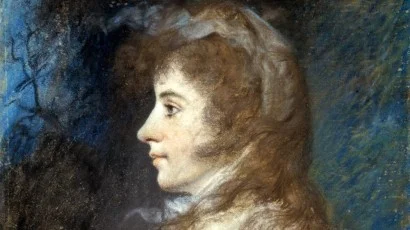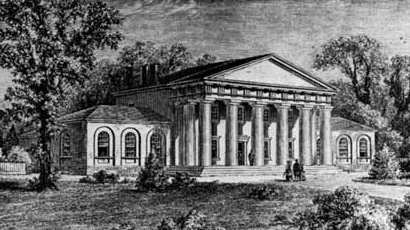
Best known in his lifetime as the adopted son of George Washington, George Washington Parke Custis eventually became a key figure in preserving the memory and possessions of Washington. He was often referred to as "Wash" or "Washy." He was the youngest child of John Parke Custis, Martha Washington's son from her first marriage, and Eleanor Calvert. He was born in April of 1781, and his father died shortly thereafter on the Yorktown Campaign. Following the death of his father, George Washington Parke Custis and his sister Eleanor Parke Custis Lewis (known as "Nelly") came to live at Mount Vernon with the Washingtons. Although their mother remarried, George and Nelly remained in the care of their paternal grandmother and step-grandfather.
Early Life
As an infant, "Washy" met George Washington for the first time in September 1781. The General was making a brief stop at Mount Vernon before the Yorktown Campaign. John Parke continued with him to the campaign as an aide-de-camp and died from an illness contracted near Yorktown. After the death of his father, his mother Eleanor remarried Dr. David Stuart in 1783. While "Washy" and "Nelly" remained with the Washington family, his two older sisters Elizabeth Parke “Eliza” and Martha Parke “Patty,” and later six surviving half-siblings continued to live with their mother. The two households remained close and visits back and forth were common, with her two eldest sisters visiting for extended periods.
Custis was raised at Mount Vernon and remained a prominent figure in Washington City and Alexandria until his death in 1857. It was remarked that Custis was indulged by his grandmother as a child at Mount Vernon. His sister Nelly recalled that "Grandmamma always spoiled him," and Custis's daughter recounted that public duties kept George Washington from offering the stern presence and discipline that could have benefited him.1
When Washington was elected president, the family relocated to New York in the spring of 1789, and then to Philadelphia in late 1790. The Custis children were in the public eye given their step-grandfather's role. By the time Custis left Virginia to attend college at Princeton in 1797, his grandfather had retired and took a more active role in shaping his ward. Washington wrote Custis frequently to encourage him to take his studies more seriously. Custis soon left Princeton for St. John's College in Annapolis but never completed his college education.
Adult Life
George Washington died in December 1799, leaving Custis his twelve hundred acre tract of land at Four-mile run in Alexandria and square 21 in the fledgling Washington City.2 After Martha’s death in 1802, George and his three Custis siblings divided about 150 people enslaved at Mount Vernon considered Custis property from her first marriage, many of whom would be separated from their families and communities at Mount Vernon.3 Custis chose to build his home on land inherited from his father at Arlington. This thousand acre piece of land was situated just across the Potomac River from Washington City, and Custis built a Greek Revival home atop a hill with expansive views of the river and the city.

In 1804, Custis married Mary Lee Fitzhugh. The couple had four children but only one, Mary Anna Randolph Custis, survived to adulthood. Recent research also indicates that Custis likely fathered numerous children in sexually exploitative relationships with enslaved women, with clear evidence that he was the father of Maria Carter Syphax.4 Custis owned landed estates worked by nearly 200 enslaved people, although he freed some of the enslaved during his lifetime and directed that all should be freed within five years of his death.
While not a financially successful plantation manager, Custis promoted American agriculture and was particularly interested in domestic sheep farming and wool production. He spent significant time attending events that commemorated his step-grandfather and his legacy. He held large parties he held on the lawn at Arlington House under George Washington's military tent.
Custis was also known for his literary and oratory skills, authoring several popular plays and having speeches reprinted in newspapers across the country. His 1812 funeral oration for press freedom advocate James Lingan was one of his most well-known pieces. His essays on George Washington were compiled and published by his daughter as Recollections and Private Memoirs of Washington in 1860.
Custis's legacy would also live on through Arlington House. His daughter married Robert E. Lee in 1831 and the Lees and Custis families resided at Arlington until Custis's death in 1857. During the Civil War, Arlington House was captured by Union troops and the grounds turned into a cemetery, which it remains today as Arlington National Cemetery.
Cassandra Good, Ph.D. Assistant Professor of History Marymount University, updated by Zoie Horecny, Ph.D., 25 June 2025
Notes:
1. George Washington Parke Custis and Mary Randolph Custis Lee, Recollections and Private Memoirs of Washington (J. W. Bradley, 1861), 38.
2. “George Washington’s Last Will and Testament, 9 July 1799,” Founders Online, National Archives.
3. Will of Martha Washington, 22 September 1800, The Clerk of Circuit Court of Fairfax County.
4. The National Park Service staff at Arlington House now present Syphax’s lineage as definitive. Custis freed Maria and her children in 1845. (Slave Manumissions in Alexandria Land Records, 1790-1863, Alexandria Hustings Court deed books, E-3:425, transcribed at http://www.freedmenscemetery.org/resources/documents/manumissions.shtml). He also gave her a seventeen acre plot of land, her claim to which was recognized by the federal government via an act of Congress (Statutes at Large, 39th Congress, 1st Session, p. 589, Chapter 121 – An Act for the Relief of Maria Syphax, June 12, 1866). She told a newspaper reporter in 1888 “I am General Custis’ daughter. He told me so face to face” (“Lovely Arlington,” Morning Star (Rockford, IL), September 4, 1888). Further research is pending on whether Custis fathered other children with enslaved women, as contemporary accounts and descendants’ oral histories suggest. Custis manumitted ten enslaved children whom he likely fathered. See Cassandra Good, First Family: George Washington's Heirs and the Politics of Family (New York: Hanover Square, an imprint of Harper Collins, June 2023).
Bibliography
Custis, George Washington Parke. Recollections and Private Memoirs of Washington, By His Adopted Son, George Washington Parke Custis. New York, NY: Derby & Jackson, 1860.
Good, Cassandra. First Family: George Washington's Heirs and the Politics of Family. New York: Hanover Square, an imprint of Harper Collins, 2023.
Fraser, Flora. The Washingtons: George and Martha Partners in Friendship and Love. Anchor Books, 2015.
Worthy Partner: The Papers of Martha Washington, ed. Joseph E. Fields. Westport, CT: Greenwood Press, 1994.


